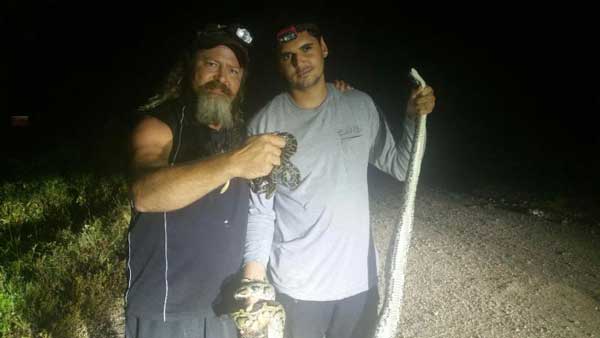The South Florida Water Management District opened its lands to help reduce the population of the invasive snake.
The South Florida Water Management District (SFWMD) Governing Board announced that hunters have captured and euthanized 500 invasive Burmese pythons (Python molurus bivittatus) in less than five months.
The board’s Python Elimination Program launched March 25 in an effort to raise awareness about the invasive reptiles that some blame for upsetting the ecological balance in the Florida Everglades. The 500th Burmese python euthanized was 7 feet in length and was captured by python hunter Jason Leon.

South Florida Water Management District
Python hunter Jason Leon (right) with 7-foot python and fellow python hunter Dustin "Wildman" Crum. Leon's snake was the 500th snake eradicated through the South Florida Water Management District's Python Elimination Program.
"The speed with which hunters are finding and eliminating these destructive snakes showcases not only their dedication to the effort, but also the enormity of this invasive predator problem in the Everglades," said SFWMD Governing Board Chairman Dan O'Keefe. "Every one of these 500 snakes killed helps ensure the lives of hundreds of native species essential to the Everglades ecosystem."
Read More
Largest Burmese Python Captured In Florida Carried 87 Eggs
National Park Service Personnel Remove 18-foot Burmese Python From Everglades National Park
District-owned lands were opened up to selected professional python hunters initially in Miami-Dade County. The hunt was later expanded to Broward and Collier counties. The hunters were paid $8.10 an hour to hunt in the Everglades. The district also offered cash incentives based on the size of the snake as well as any python nests the hunters came across and eliminated.
The Burmese python is one of the largest snakes in the world and is native to Southeast Asia. It can grow up to 20 feet and reach a weight of more than 300 pounds, though most top out around 13 to 14 feet and weigh around 130 pounds. Captive bred specimens have a mostly docile disposition, so much so that they are often called the gentle giants of the large constricting snakes.



